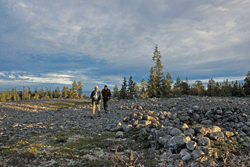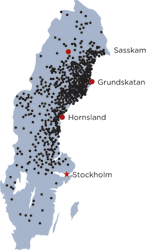
Posted on 06/15/2008 8:34:34 AM PDT by blam
Native Sweden
Volume 61 Number 4, July/August 2008
by Zach Zorich
Indigenous Saami are rediscovering their long-lost heritage

Smithsonian archaeologist Noel Broadbent and Tim Bayliss-Smith of Cambridge University walk past a line of 1,100-year-old hut foundations at Grundskatan. (Zach Zorich)
Smithsonian archaeologist Noel Broadbent offers me a handful of blueberries he has picked from the shrubs that hug the forest floor. I pop them into my mouth. The pulp and seeds are sugary, rough, and slick at the same time. In early September the leaves change color and the berries ripen on Sweden's Hornsland peninsula.
Broadbent crouches by the trail and picks up a hunk of pale gray lichen. "This is what the reindeer eat," he announces before letting it fall to the ground. But the sun is beginning to dip below the treetops and I am too preoccupied with getting to the archaeological site before dark to notice that this is my first lesson in how the landscape fed the ancestors of the Saami people and what meanings the geography held for them.
The Saami (formerly called Lapps) have lived in northern Scandinavia and Russia's Kola peninsula since the glaciers retreated some 10,000 years ago. Today, they number fewer than 100,000 people, many of whom have assimilated into Scandinavian culture but still maintain ties to their ancestral lands and family reindeer herds.

The black dots on the map show the distribution of places with Saami names, evidence that they had once settled far beyond the borders of "Lapland."
Because the Saami are historically known from the accounts of priests and government officials, they have been stereotyped as nomadic reindeer herders who live only in what was once called "Lapland," an area that extends from the coast of the Arctic Ocean 300 miles south of the Arctic Circle in Sweden.
Except for the work of Broadbent and a few others, Saami prehistory before they adopted reindeer herding 400 or 500 years ago is largely a blank slate. Historic texts identified them as hunters who traveled on skis, but said little else. This lack of history has made it difficult for modern Saami to establish their rights to land that was once used for grazing their reindeer. "It is a common problem of indigenous people around the world," Broadbent says. "People without written histories of their own can be helped by archaeology in asserting their rights to their own history."
A 2002 decision by a Swedish court ruled that archaeological evidence was not admissible in land-rights cases. Nevertheless, Broadbent's work is helping to define ancient Saami history, part of which comes from the site at Hornsland on the coast of the Gulf of Bothnia, 500 miles south of the Arctic Circle.
The Swedish state and landowners are claiming rights to land far north of here, based on the assumption that the Saami never settled this far south. Broadbent doesn't see himself as an activist, but that doesn't make his finds less controversial or less important in helping the Saami establish their cultural identity.
What I gather from digging through hundreds of names in the Kola Peninsula and Finland (over the last 3 years or thereabouts now that I discovered where so many of the ancestors came from) it seems to me that a Sa'ami place name probably is the secondary name with a place with a regularized Finish name.
Same ought to be true for Sweden as well.
However, Finland can serve as a good template for all the other places in the Scandinavian peninsula because, ta-ta-ta-da-daa, in the imposition of the Swedish form of governance on Finland (in 1600s/1700s) the intellectual class that popped up in Helsinki (et al) thought to "fill in" all the linguistic gaps by adopting Latin words rather than German or Swedish (Gothic) words. That's what gives that utterly strange language called Finish such an otherworldly English Language feel ('cause that's what English intellectuals did as well ~ slip in lots of Latin).
So, whenever I read a place name in Finland that I can at all "understand" because of its Latin content, I know to look for a secondary name previously applied to the place. If it looks totally bizarre, and doesn't even "bounce" like Hungarian or Estonian (Finish cognates), odds are good that it's a Sa'ami name.
There are an almost unlimited number of such names BTW.
We were left with so few Sa'ami words by our ancestors (brogalis = bib overhauls worn to work with reindeer; amarugia = "reindeer" crossing; maybe some others), I can't say I'm an expert in this, but I had to learn a tremendous amount of vocabulary in Sa'ami, Finish, Latvian, Old West Gothic, to even begin to figure that out.
Folks who study French history have a secret. Learned this one years ago from some professionals in French studies who'd managed to get paid for books they'd published ~ first take a Michelin guide and learn the geographic and political reference points in the area covered by the guide (usually a couple, maybe three pre-Revolutionary provinces). Then, learn the names of all the Medieval Castles. Then, learn the names of all the Chateaux built from about 1600 onward.
That gives you a grasp of the country and will enable you to properly organize in your mind any primary or secondary source materials you might encounter, and also allow you to infiltrate that material with tertiary histories and intelligence briefings on that area.
Language is the same. With respect to Scandinavian place names they all initially seem to be nonsense words. Then you discover they are mostly abbreviated sentences, and then finally, they are also in Sa'ami ~ and you don't know any Sa'ami.
Now, to make a quick job of identifying Sa'ami names, get a couple of maps and start circling the strangest possible stuff, or anything with "mu" in it. Means "reindeer" in many Sa'ami languages. Also, all the names with "rgu" (hard g) in them.
Might help to do a google.com search for "sa'ami place names". Could get a surprise ~
It's not original with the Goths at all.
Best I can tell most the Sa'ami have blue, gray, blue/gray, or heavily pigmented eye color ~ in the same family too. Remember, colorless eyes are an aid to survival in the Far North. At the same time these guys have been part of the Iron Age for the last thousand years so they do get around!
question, what genetic test should I take, there’s a few out there which one have you heard gives the best database of results?
Neither test tells you anything about Celiac, Red vision, night vision, blue cones, Scandinavian porphyria, and so forth, all genetically controlled characteristics.
Disclaimer: Opinions posted on Free Republic are those of the individual posters and do not necessarily represent the opinion of Free Republic or its management. All materials posted herein are protected by copyright law and the exemption for fair use of copyrighted works.